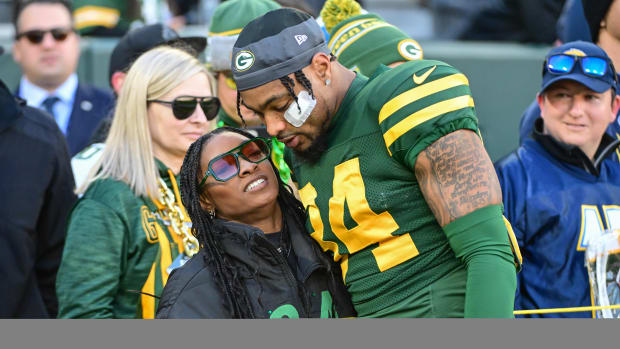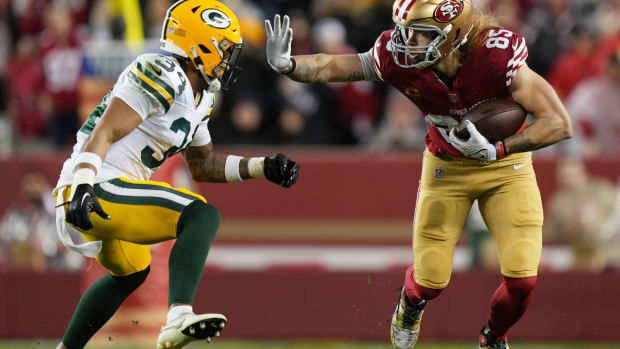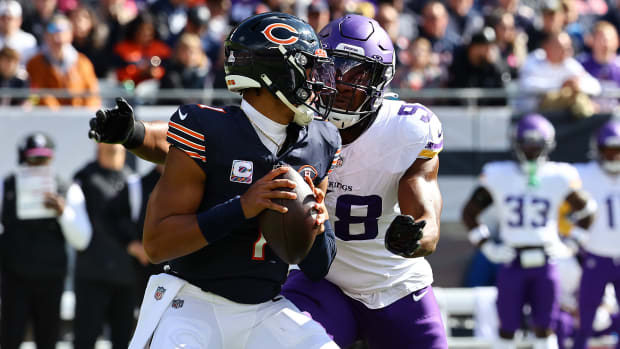Tee Higgins to the Bears?
The dead period for most teams until the start of the NFL combine stirs up plenty of wishful thinking and potential trades among fans.
You could build a generational dynasty in your own mind off of the rumors in any given year during these weeks.
The latest news to create a stir was the thought that Cincinnati Bengals wide receiver Tee Higgins could be someone they would trade. It's not a reported story but only rumor based on some sound logic, like, it's going to cost the Bengals too much to keep Joe Burrow and their top two receivers.
Of course, Bears fans see this as an opportunity to obtain a target for Justin Fields.
It's an opportunity all right.
It's an opportunity for the Bears to continue floundering in the same way they have over the past four years. It's regression.
The thinking is Justin Fields hasn't flourished because he lacks that top veteran receiver to throw to, someone like Stefon Diggs was to Josh Allen and A.J. Brown has been to Super Bowl QB Jalen Hurts. Higgins would be to Fields what those two receivers have been to their young quarterback.
It's true he hasn't had as many weapons as he needs, but there's more involved with obtaining Higgins than just trading a couple of late-round draft picks and putting him on the field.
The Bears are rebuilding and haven't reached a stage to pursue a piece like this. It would diminish their attempt to put together a team.
Here's why they're better off not pursuing Higgins.
1. Higgins Isn't a Fit
The offense they're using doesn't suit Higgins. Just before the AFC championship, Chiefs safety Justin Reid referred to Higgins as "... more of a finesse type of guy, not the best blocker."
That's a red flag for the Bears offense right there. The starting X-receiver needs to block in Luke Getsy's offense and be good at it.
This is the least important reason not to do it. After all, the position is wide receiver, not wide blocker.
2. Not a No. 1 Receiver
Higgins isn't even a No. 1 receiver. There's no question who the top receiver in Cincinnati is. Ja'Marr Chase has been the guy since arriving. Stefon Diggs was the top Vikings receiver when he was sent to Buffalo, and then they drafted Justin Jefferson after trading him to the Bills.
Higgins has never been in the top 25 in receptions. He made it to 17th and 20th in receiving yards the last two years but never higher.
In fact, Higgins didn't even have as many catches in his second season as Darnell Mooney (81) did, and he had Chase as a main Bengals target drawing away attention from the defense while Mooney had Allen Robinson, the 2021 zombie version of Robinson who drew nothing but dirty looks.
3. The Cost
There are two parts to this.
Drafting your own No. 1 receiver, like Minnesota did at No. 22 with Jefferson, allows a team four years of relatively inexpensive play before his contract is up and the cash skyrockets. The reason the Bengals would even be looking to deal Higgins is they have to pay both Joe Burrow and Chase soon. Trying to do this will make the kind of money Higgins wants difficult. According to reports, it's expected to be a huge amount.
The other cost is in terms of draft picks to make the trade.
It's going to cost a first-round draft pick. There's no way around this. Some team that would want Higgins will want to offer a No. 1.
Do the Bears need to offer a first-round draft pick for a receiver who comes to them in his fourth season and is going to cost them a lot of money?
The Bears don't even have the first-round pick, per se, that they would need to trade to get Higgins.
If Chase Claypool was worth the first pick of Round 2 in the draft, then Higgins most definitely would be valued at no worse than mid-to-later first round. The Bears have no picks like that. Their first-rounder is the top pick in the draft.
They would either need to trade the first pick of the draft for Higgins or make a deal where they get back compensation beyond Higgins. Higgins and the Bengals' first-round pick, which is No. 28, for the first pick of the draft? It's a long drop down to 28 in talent from No. 1. That doesn't seem fair. Even a second-rounder thrown in seems insufficient.
You're getting a good receiver but not an elite one in the league when you could have the elite defensive lineman of the draft. Even if they threw in next year's No. 1 it might not be worth the trade. Next year's No. 1 is only worth the start of the next round in the draft value chart. So it's basically a future second-round pick.
The Bears have a roster totally void of talent. They have two first-round draft picks and one of them, Alex Leatherwood, wasn't their pick and was obtained on waivers. They have more players taken on Day 3 or undrafted than they have chosen in Rounds 1-through-3. What they need is more young first-round talent, players who will be at Halas Hall from their first day of the draft. And they really need a talent who is worthy of the top pick or top four picks in the draft.
4. The Plan
A move like this shoots holes in the entire Bears plan to rebuild.
Poles said during the postseason press conference, just as he did when he was hired, that the idea is to build through the draft and do this in a way to create "sustained success." They want a team good for numerous years and not one year before three years of mediocrity.
The Bears do this by keeping their own picks and using them to build their own team.
The salary cap is managed easier this way as second contracts for players are planned for and eventually signed.
You're not going out, throwing away draft picks after some other team's cast-off player who is going to be overpaid as a veteran and eat up cap space in a way that wasn't initally part of the plan.
Trading away draft picks leads to signing more free agent players to contracts with bonuses pushed off into future years and a strapped salary cap just like they had under former GM Ryan Pace.
In other words, you're going right back into the cycle of defeat they had under Pace. So what was the point of firing him and bringing in Ryan Poles if you're just going to do what Pace would have done?
5. They Might Already Have Their No. 1
It's easy to look at what Claypool did after he got here last year and say he's merely a No. 2 receiver or less.
Higgins is merely a No. 2 in Cincinnati.
Higgins would be a No. 1 in Chicago, it's suggested, and he might. But how can anyone say for certain Claypool wouldn't be a No. 1 in Chicago? He hasn't had time in the offense or working with Fields to prove what he could do.
Claypool missed two games due to injury and most of another one as they slowly worked him back into the lineup following the injury. That was the Detroit game where he had only 19 plays and on many of those Fields was too busy being sacked to pass to him.
Fields missed two other games with injuries when Claypool was healthy. That left four games when the two were working together fully healthy and three of those were the first three weeks after Claypool came on board. He was still trying to pick up their offense then.
For that matter, no one can say Mooney isn't the No. 1. He played like one in 2021. He had an ankle injury last year just as his catch and yardage totals started moving upward.
Ultimately, trading for Higgins might give them another receiver. It could even be a No. 1 receiver.
But one thing it definitely would do is take away their chance at building the defense and overall team they want through the draft.
The Bears are not at the stage of their rebuild when throwing away draft picks for a possible No. 1 receiver is a wise use of their personnel. It would make sense in 2024 but not now.
Twitter: BearDigest@BearsOnMaven





